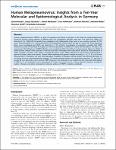Human Metapneumovirus: Insights from a Ten-Year Molecular and Epidemiological Analysis in Germany
Reiche, Janine
Jacobsen, Sonja
Neubauer, Katrin
Hafemann, Susi
Nitsche, Andreas
Milde, Jeanette
Wolff, Thorsten
Schweiger, Brunhilde
Human metapneumovirus (HMPV) is a cause of respiratory tract illness at all ages. In this study the epidemiological and molecular diversity among patients of different ages was investigated. Between 2000–2001 and 2009–2010, HMPV was detected in 3% (138/4,549) of samples from outpatients with influenza-like illness with a new, sensitive real-time RT-PCR assay. Several hundred (797) clinical specimens from hospitalized children below the age of 4 years with acute respiratory illness were investigated and HMPV was detected in 11.9% of them. Investigation of outpatients revealed that HMPV infections occurred in individuals of all ages but were most prevalent in children (0–4 years) and the elderly (>60 years). The most present clinical features of HMPV infections were cough, bronchitis, fever/shivers and pneumonia. About two thirds of HMPV-positive samples were detected in February and March throughout the study period. Molecular characterization of HMPV revealed a complex cyclic pattern of group dominance where HMPV subgroup A and B viruses predominated in general for three consecutive seasons. German HMPV represented all genetic lineages including A1, A2, B1, B2, sub-clusters A2a and A2b. For Germany, not only time-dependent circulation of lineages and sub-clusters was observed but also co-circulation of two or three predominant lineages. Two newly emerging amino acid substitutions (positions 223 and 280) of lineage B2 were detected in seven German HMPV sequences. Our study gives new insights into the molecular epidemiology of HMPV in in- and outpatients over a time period of 10 years for the first time. It is one of only few long-term surveillance studies in Europe, and allows comparative molecular analyses of HMPV circulating worldwide.
Dateien zu dieser Publikation
Keine Lizenzangabe
Verwandte Publikationen
Anzeige der Publikationen mit ähnlichem Titel, Autor, Urheber und Thema.
-
2014-04-10ZeitschriftenartikelResults of surveillance for infections with Shiga toxinproducing Escherichia coli (STEC) of serotype O104:H4 after the large outbreak in Germany, July to December 2011 Frank, Christina; Milde-Busch, Astrid; Werber, DirkAfter the massive outbreak of infections with Shiga toxin-producing Escherichia coli (STEC) of serotype O104:H4 in Germany in the summer of 2011, post-outbreak surveillance for further infections with this type of STEC was ...
-
2015-08-27ZeitschriftenartikelTransmission patterns of human enterovirus 71 to, from and among European countries, 2003 to 2013 Hassel, C.; Mirand, A.; Lukashev, A.; Terletskaia-Ladwig, E.; Farkas, A.; Schuffenecker, I.; Diedrich, Sabine; Huemer, H. P.; Archimbaud, C.; Peigue-Lafeuille, H.; Henquell, C.; Bailly, J.Enterovirus 71 (EV-71) is involved in epidemics of hand, foot, and mouth disease (HFMD) and has been reported to occur with severe neurological complications in eastern and south-east Asia. In other geographical areas, the ...
-
2015-06-24ZeitschriftenartikelEbola Virus Disease Outbreak in Isiro, Democratic Republic of the Congo, 2012: Signs and Symptoms, Management and Outcomes Kratz, Thomas; Roddy, Paul; Oloma, Antoine Tshomba; Jeffs, Benjamin; Ciruelo, Diana Pou; Rosa, Olimpia de la; Borchert, MatthiasData collected during the 2012 Ebola virus disease (EVD) epidemic in the Democratic Republic of the Congo were analysed for clinical signs, symptoms and case fatality of EVD caused by Bundibugyo virus (BDBV), establishment ...

